Things to See in the Languedoc: Historic Villages and Bastides: Rennes-les-Bains
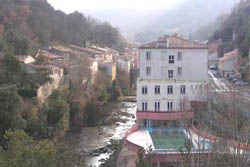

- its history as a spa town since Roman times
- its role as a sister village of Rennes-le-Chateau
- its curé, Abbé Henri Boudet
- its supposed links with Bertrand de Blanchefort, Grand Master of the Knights Templars
- its role in Kate Mosse's 2007 novel Sepulchre.
The Spa.

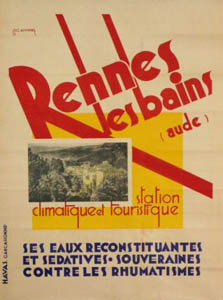
Coins and other Archaeological artefacts show that its spa was popular with the Roman colony of Colonia Narbo Martius (an area corresponding to modern Languedoc & Provence) named after what is now the city of Narbonne) which stretched as far as Termes, a few miles south of here.
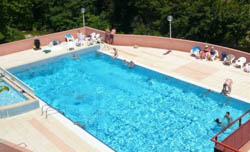
Today, it is a modern thermal spa with the latest on "thermalisme" equipment. Waters here are still used today as a cure for rheumatism and certain skin problems.
|
|
|
The TownUntil the 18th century Rennes-les-Bains was known in as Les Bains de Monferan. Montferrand is a village on a hill to the northwest. Today Rennes is a sizable popular village and Montferrand a small satelite, but it used to be the other way round. Rennes-les-Bains was the satelite spa of Montferrand in the valley below it. Anciend documents invariably refer to Montferrand.A Roman bridge stood here until 1994 when a flash flood destroyed the town, killed a number of people and washed away the bridge that had withstood 2000 years of local weather - all early victims of global warming. 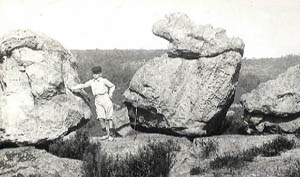 Things to do include tennis, pétanque, badminton, basket ball, the river for angling and fishing and miles of interesting countryside. The village features on a Lonely Planet guide cycling route. Horse riding, walking, fishing, canooing and kyaking on the world-class River Aude, white water rafting, climbing, caving and hot air ballooning are all available nearby. Many of the local facilties are subject to seasonal opening hours. Espace d'Art is an art gallery on the main road through the village, which exhibits local artists. Rennes-les-Bains lies in the Arrondissement of Limoux and the Canton of Couiza. Its latitude and longitude are : 42 ° 55 ′ 11 ″ N 2 ° 19 ′ 11 ″ and ts elevation is 254 m–822 m (avg. 310 m) above sea level. the village's land area is 18.77 km² and population around 160. INSEE code 11310 Postal code 11190 |
|
|
|
Abbé Henri Boudet
Abbé Henri Boudet was the parish priest of Rennes-les-Bains at the same time that Bérenger Saunière was the incumbent of Rennes-le-Château. Boudet's book, La vraie langue celtique et le cromleck de Rennes-les-Bains (1886) argued that all languages were derived from the English tongue. Boudet tried to establish his theory through the use of some improbable word play.Boudet was born in Quillan in 1837. He was Abbé (ie priest) at Rennes-les-Bains from 1872 to 1914. He was ordained on Christmas day, 1861, having attended the Seminary in Carcassonne. He served as vicar in nearby Durban in the Corbieres in 1862. He held a degree in English and was proficient in many languages and dialects, and the author of several curious books, most notably 'The True Celtic Language and the Cromlech of Rennes-les-Bains'. This book is said to contain codes and riddles which suggests that a hidden treasure or secret is preserved in the region as well as the fact that a gigantic stone circle encircles the whole of Rennes-les-Bains.
Abbe Boudet a friend of Abbe Saunière, the priest in nearby Rennes-le-Château. According to some Rennes-le-Chateau conspiracy theorists, Boudet inherited a great secret from Abbe Jean Vie (his predecessor as Abbe in Rennes Les Bains), who in turn inherited it from Abbe Cauneille, who received it from Abbe Bigou, who had heard it from the Noble Marie de Nègre d' Ables. It is also said that Boudet was responsible for changing the date on Abbe Jean Vie's tombstone, from 31 August 1872 to 17 January.
Abbe Boudet said to have provided large sums of money to Saunière's housekeeper, Marie Denarnaud, and Archbishop Billiard, though he himself died a poor man. On his tombstone is a small raised platform some 8 inches long and 4 inches wide which may represent abook. On the surface are 5 , raised letters that appear to spell 31OXI, which some people say refers to chapter 11, page 310 of The True Celtic Language and the Cromlech of Rennes-les-Bains.
The theory that Boudet's book has an alternative meaning is supported by what may have been his inspiration - Jonathan Swift, In 1719 Swift wrote a book called the Ars Punica, or The Art of Punning, which outlines a preposterous theory that English was once the common language of all mankind. Professor Jean Richer at the Faculty of Letters in Nice has argued that this work of Swift's is based on the rules found in alchemical treatises. Boudet died of intestinal cancer in 1915 in Axat, a short distance south of Rennes-le-Château, age 78.
You can read an English translation of La vraie langue celtique et le cromleck de Rennes-les-Bains by Marcus Williamson on his Rennes-le-Château Home Page

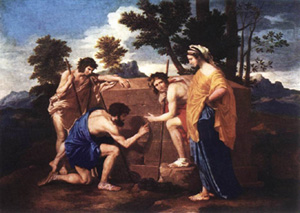
 In 1832 a book by Auguste de Labouïsse-Rochefort entitled Voyages à Rennes-les-Bains
first referred to a treasure located at Mont Blanchefort. It related a
story about a wizard who almost succeeded in taking the purse-strings
of the Devil, but failed because the local villagers did not help him at
the crucial moment. In Les Amours A Éléonore, recueil d’élégies divisé en Trois Livres
(1817), de Labouïsse-Rochefort used the motto "Et in Arcadia ego" on
the books title page; this was a reference to the Academy of Arcadia
that was formed in Italy in 1690 - Labouïsse-Rochefort became a member
of the Academy in 1832, but the phrase and painting of the same name by
Nicolas Poussin would become a major feature in various alleged mysteries surrounding Rennes-le-Château.
In 1832 a book by Auguste de Labouïsse-Rochefort entitled Voyages à Rennes-les-Bains
first referred to a treasure located at Mont Blanchefort. It related a
story about a wizard who almost succeeded in taking the purse-strings
of the Devil, but failed because the local villagers did not help him at
the crucial moment. In Les Amours A Éléonore, recueil d’élégies divisé en Trois Livres
(1817), de Labouïsse-Rochefort used the motto "Et in Arcadia ego" on
the books title page; this was a reference to the Academy of Arcadia
that was formed in Italy in 1690 - Labouïsse-Rochefort became a member
of the Academy in 1832, but the phrase and painting of the same name by
Nicolas Poussin would become a major feature in various alleged mysteries surrounding Rennes-le-Château.|
|
|
|
 |
|
|
|
|
 |
|
|
|
|
 |
|
|
|
|
Blanchfort and Bertrand de Blanchefort
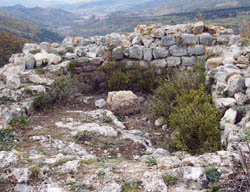
Youtube video of the Château de Blanchefort

According to other Rennes-le-Château conspiracy theorists the local family of Blanchefort provided a Grand Master of the Knights Templar. Certainly, the sixth Grand Master of the Knights Templar, from 1156 until his death in 1169 was Bertrand de Blanchefort, a reformer of the order. Bertrand was born around 1109. An obituary at Reims gives his death as 2nd January 1169. He trained in combat from a young age. During his time as Grand Master he placed emphasis on reform and negotiation. His earliest action as Grand Master was with Baldwin III of Jerusalem, with whom he fought against Nur ad-Din. He was ambushed and taken prisoner after Baldwin was defeated at Banyas in 1157. He was held in captivity for three years in Aleppo before being released to Byzantine Emperor Manuel I Comnenus when the emperor made peace with Nur ad-Din.
Bertrand accompanied King Amalric I during the uncussessful crusader expedition against Egypt in 1163 but refused to participate in a second expedition in 1168. Blanchefort successfully petitioned the Pope to use the title, "Master by Grace of God".
From the 1960s onwards it was asserted by a number of writers that Bertrand de Blanchefort was a member of the de Blanchfort family located near Rennes-le-Château. This assertion was easily discredited as it was known that this Bertrand was the youngest of a family of boys, children of Godfrey de Blanchefort who lived in Guyenne.
It is also claimed that the castle of Blanchfort was attacked and destroyed by the Crusader armies of Simon de Montfort, presumably after his siege of Termes. This is possible but (as far as I know) undocumented. Contemporary sources mention only the rendition of nearby Albedun (Modern Le Bézu) and of Coustaussa.
Another key personality in the Rennes-le-Château mystery is Marie de Blanchefort, aka Marie de Négri d’Ables, Countess Hautpoul de Blanchefort.
Rennes-les-Bains Trivia
Since July 1985 the village has been twinned with the city of Rennes in Brittany. There is no reason except the similarity in their names.Kate Mosse set the larger part of her 2007 novel Sepulchre in the immediate vicinity.


Aucun commentaire:
Enregistrer un commentaire